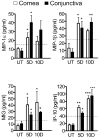Ocular surface immunity: homeostatic mechanisms and their disruption in dry eye disease
- PMID: 22426080
- PMCID: PMC3334398
- DOI: 10.1016/j.preteyeres.2012.02.003
Ocular surface immunity: homeostatic mechanisms and their disruption in dry eye disease
Abstract
The tear film, lacrimal glands, corneal and conjunctival epithelia and Meibomian glands work together as a lacrimal functional unit (LFU) to preserve the integrity and function of the ocular surface. The integrity of this unit is necessary for the health and normal function of the eye and visual system. Nervous connections and systemic hormones are well known factors that maintain the homeostasis of the ocular surface. They control the response to internal and external stimuli. Our and others' studies show that immunological mechanisms also play a pivotal role in regulating the ocular surface environment. Our studies demonstrate how anti-inflammatory factors such as the expression of vascular endothelial growth factor receptor-3 (VEGFR-3) in corneal cells, immature corneal resident antigen-presenting cells, and regulatory T cells play an active role in protecting the ocular surface. Dry eye disease (DED) affects millions of people worldwide and negatively influences the quality of life for patients. In its most severe forms, DED may lead to blindness. The etiology and pathogenesis of DED remain largely unclear. Nonetheless, in this review we summarize the role of the disruption of afferent and efferent immunoregulatory mechanisms that are responsible for the chronicity of the disease, its symptoms, and its clinical signs. We illustrate current anti-inflammatory treatments for DED and propose that prevention of the disruption of immunoregulatory mechanisms may represent a promising therapeutic strategy towards controlling ocular surface inflammation.
Copyright © 2012 Elsevier Ltd. All rights reserved.
Figures








References
-
- Abelson MB, Heller W, Shapiro AM, Si E, Hsu P, Bowman LM AzaSite Clinical Study Group. Clinical cure of bacterial conjunctivitis with azithromycin 1%: vehicle-controlled, double-masked clinical trial. Am J Ophthalmol. 2008;145:959–965. - PubMed
-
- Ambati BK, Nozaki M, Singh N, Takeda A, Jani PD, Suthar T, Albuquerque RJ, Richter E, Sakurai E, Newcomb MT, Kleinman ME, Caldwell RB, Lin Q, Ogura Y, Orecchia A, Samuelson DA, Agnew DW, St Leger J, Green WR, Mahasreshti PJ, Curiel DT, Kwan D, Marsh H, Ikeda S, Leiper LJ, Collinson JM, Bogdanovich S, Khurana TS, Shibuya M, Baldwin ME, Ferrara N, Gerber HP, De Falco S, Witta J, Baffi JZ, Raisler BJ, Ambati J. Corneal avascularity is due to soluble VEGF receptor-1. Nature. 2006;443:993–997. - PMC - PubMed
-
- Aragona P, Bucolo C, Spinella R, Giuffrida S, Ferreri G. Systemic omega-6 essential fatty acid treatment and pge1 tear content in Sjögren’s syndrome patients. Invest Ophthalmol Vis Sci. 2005;46:4474–4479. - PubMed
Publication types
MeSH terms
Substances
Grants and funding
LinkOut - more resources
Full Text Sources
Miscellaneous

